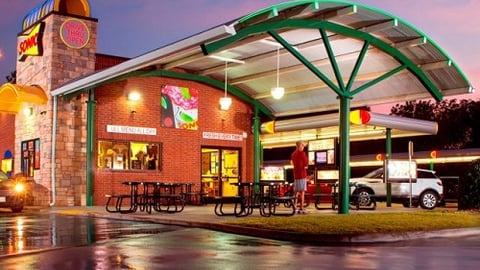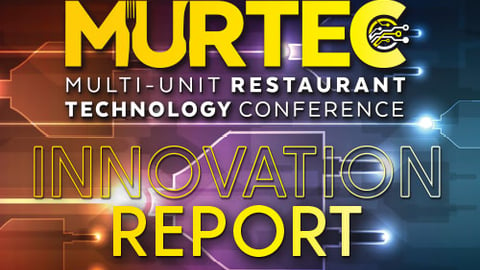Evolution of the Drive-Thru
Customers’ demands for convenience and personalized service — combined with operators’ desires for greater efficiencies and more profit — have positioned the drive-thru for its next-generation transformation.
This world of possibilities — some in practice, some on the horizon — coincide with the increase in off-premise dining, including digital orders and third-party delivery.
Online ordering is only going to grow, and the drive-thru is becoming the grab-and-go spot dedicated to digital orders, says World Wide Technology (WWT). Many brands, not just QSRs, are looking at reinventing their stores to add a drive-thru. QSRs that currently operate drive-thrus are modifying their approach. They can’t afford not to.
For Jack in the Box, 70% of its business comes through the drive-thru, which is inline with the industry average. The QSR is planning a “major overhaul of the drive-thru experience” that will begin appearing later this year, said Chairman and CEO Lenny Comma during a Q1 earnings call with analysts. About half of its dining room orders are for takeout. “Drive-thru enhancement is probably the number-one area of focus for capital investments,” he said.
Driving Innovation
Major brands are investing in a next-gen drive-thru. Dunkin’ made a splash in January 2018 when it opened its prototype that included its first drive-thru dedicated to mobile pickup of orders placed using the DD Perks app.
In August, the Canton, Mass.-based QSR said it will invest $100 million — in store equipment, technology infrastructure and training — to roll out 50 or so of these next-gen prototypes, reported the Wall Street Journal. About 130 new and remodeled locations include “a more prominent mobile order pickup station,” said chief marketing officer Tony Weisman in a February earnings call with analysts.
As customers seek out more off-premise dining options, the influx of digital orders have brands scrambling to modify their setups.
Last year Chipotle began testing its version of a drive-thru — drive-up pickup lanes called Chipotlanes — that are dedicated to mobile order pickup. Digital orders for the fast-casual brand’s business skyrocketed 66% in 2018 to account for 10.9% of sales. The drive-up pickup lanes will be expanded to a few dozen of Chipotle’s 2019 restaurant openings.
“Chipotlane is showing promising results with a higher mix of digital sales and total restaurant sales,” said CEO Brian Niccol, in an earnings call with analysts. “These restaurants are a great extension of our digital system as they help to increase convenience and access to Chipotle.”
Chowly, an integrator of third-party delivery services with point-of-sale systems, says more non-traditional drive-thru brands will begin to transform their stores to focus more on off-premise, pointing to Chipotle’s initiative to add a second make line to all of its 2,500 stores by year’s end. Also on the rise are “drive-thru pop-ons” where pickup windows are added to stores, such as at mall-based locations that orginally did not have a drive-thru.
To adapt to the influx of digital orders, Salsarita’s Fresh Mexican Grill, began with developing a new prototype that improved kitchen efficiency, followed by opening its first drive-thru in 2017. CEO Phil Friedman said adding a drive-thru was part of his “long-term ambition” since he bought the Louisville, Ky.-based brand in 2011.
Like Chipotle, Salsarita’s is adding a supplemental make line for both drive-thru and digital orders that are placed through its mobile app and third-party delivery sites.
The Sound of Silence
Even more technology advances are forecasted for the drive-thru.
“Trends don’t operate in silos,” says Daniel Levine, trends expert with the Avant-Guide Institute in New York. “What we see happening all over the place” — robotics, AI, facial recognition, voice ordering — “is changing QSR and the drive-thru.”
Levine says restaurants should look to the supermarket industry for inspiration. For example, Walmart’s mobile grocery ordering app uses geolocation and geofencing technology to alert employees when a customer arrives for curbside pickup. Burger King Finland debuted its twist on this approach in February with its first Silent Pick Drive in Helsinki.
Finnish are stereotyped as being shy, and the marketing around this new mobile ordering and curbside delivery concept plays into it.
Here’s how it works: Finns download and register in the Restis mobile app. Customers then order, pay via credit card and decide when they want to pick up the order. Customers park in the Silent Pick Drive area. No talking is required; the order is delivered by a “silent yet smiling” Burger King employee.
Early results have left Burger King Finland speechless. Almost. During opening weekend the ordering process was seven to eight minutes faster, said Toni Flyckt, the marketing director of Burger King Finland, in a statement. “That’s a significant number.” Fourteen additional Silent Pick Drives will open this spring.
Finns aren’t the only market for this concept. Levine points to tech-loving millennials around the globe. “From a cultural perspective, millennials don’t like to talk on the phone. They don’t love talking to people.”
This could bode well for voice ordering. Sources interviewed by HT say this form of AI will become more commonplace in the drive-thru as QSRs continue to face high turnover in a tight labor market.
In January, Good Times Burgers and Frozen
Custard started using Valyant AI’s conversational AI customer service platform in one of its Denver drive-thrus during the breakfast rush. Scott Lefever, chief operating officer at Good Times, says the solution is “freeing employees to spend more time focused on the customer at the window. We’re providing better and faster service to our customers and a more enjoyable experience for our employees.” In the few months Good Times has been using the platform, there has been a 10-25% reduction in wait times.
During breakfast, Good Times is usually staffed with three employees, and the platform helps team members who are juggling multiple tasks. This virtual assistant can consistently take orders and always remembers to upsell. To help with order accuracy and customer service, the system uses human-in-the-loop (HITL) on all orders.
Initial feedback from employees and customers has been overwhelmingly positive, so much that Good Times is extending the platform to lunch and dinner in the next 60 days.
Future Look: Digital Signage
Operators and vendors alike agree that the drive-thru of the future will become faster and even more seamless as the adoption of these emerging technologies become more widespread.
Long John Silver’s has seen a marked improvement in its speed of service since implementing its new "drive-thru of the future" concept at 86 locations. This is a core part of rebranding the 1,000 company-owned and franchised locations. The updated system features three 55-inch high definition digital video screens backed by a digital audio driven by a computer-operated ordering and display system.
“We basically have improved every aspect of the consumer’s experience going through the drive-thru, by installing state-of-the-art headsets, timers and the menu board with order confirmation,” says Chris Fuller, director of merchandising for Long John Silver’s. “This is being executed to improve communication, speed and accuracy. We are able to measure and test in a much faster way by utilizing data driven and consumer feedback on every aspect of the consumer visit.”
Updated stores are enjoying the efficiencies’ enabled by the new technology, including the ability to update their menu boards with ease.
Salsarita’s is among the operators looking at adding interactive signage. The application of seamless ordering with mobile and touch-screen displays can provide an enhanced experience, says Samsung.
In the future Levine sees more interaction between guests’ phones and restaurants’ signage.
“We are entering a time where phones and wearable devices read our emotions. This is relevant to QSRs and restaurants that might want to direct you to what you order,” he explains.
Future Look: Payments
Streamlining the payments process is a high on the wish-list of operators and vendors; payments can take up to 30% of the time it takes to complete a drive-thru transaction.
Valyant AI and Levine are among those that predict that payments will become automated in the next five years. This could be through a mobile app, biometrics or integrated with facial recognition to charge the card on file, says Valyant AI.
As drive-thru evolves, Paytronix says identifying the customer at the beginning of the transaction will become more important for operators to provide personalized customer experience.
5Thru is piloting technology that solves both. 5Thru identifies customers by scanning their license plates and linking that information to their customer profile. As customers enter the drive-thru, their pre-scanned vehicle ID pops up a profile before they get to the menu board, which creates a “know-your-customer” opportunity for employees to offer personalized experience. Once they’ve opted in to the solution, customers can save their credit card information to their file for future payments. These customer profiles, combined with pre-pay capability, create faster, accurate service and greater upsell opportunities, 5Thru says.











